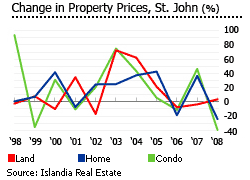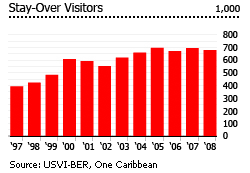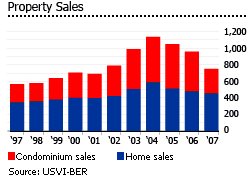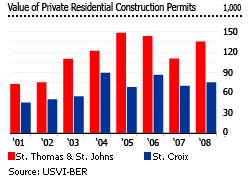US Virgin Islands' property market still down, but poised to recover
The housing market in the US Virgin Islands has still not quite recovered from its crash in 2008, but reports of new property developments suggest optimism.
In St Thomas, the average sales price for all homes, condominiums and land fell 15% in 2008 from a year earlier, according to realtor Marsha Maynes. The average price of two to three-bedroom single family residences in 2008 was about US$600,000; two-bedroom oceanfront condominiums were priced around US$400,000.

In St John, the average price of condominium units plummeted to around US$300,000 this year, down 50.5% from 2009 prices. The average home sales price dropped 14% to US$1.28 million in 2009, but has rallied in 2010 with a 7% increase to US$1.37 million according to Islandia Real Estate. And the market for villas has started to look up in 2010 with a 15% increase in sales from 2009.
In St Croix, average home sales price fell 7.4% to US$356,954 in 2009, according to the USVI Bureau of Economic Research. Condo prices, however, rose by the same percentage to an average of US$234,619 in 2009, even though the number of actual units sold dropped from 108 to 60 over the same year.
Property prices in the USVI rose 88.6% for homes and 89.3% for condo units from 1999 to 2009, based on figures from the USVI Bureau of Economic Research, with prices peaking in 2007-2008 just before the global economic downturn. St. Thomas and St. John saw a particular spike in 2007 with a record US$782,938 in the average home price but dropped sharply by US$221,000 the following year.
PROPERTY PRICE CHANGE (1999-2009) |
|||
| HOME PRICE CHANGE(%) | CONDO PRICE CHANGE(%) | ||
| St John/St Thomas | |||
| St Croix | |||
| US Virgin Islands | |||
| Source: USVI Bureau of Economic Research | |||
Despite the housing market crash, real estate prices in the US Virgin Islands are still among the highest in the Caribbean region. St John has the most expensive residential properties in the islands, followed by St Thomas.
Tourism-driven economy

The economy of the US Virgin Islands is largely dependent on tourism, which generates about 80% of GDP. Tourist arrivals went down 7.7% from 2.4 million in 2008 to 2.2 million in 2009, with the number of stay-overs dropping by as much as 13,000. However, in 2010 the rate of total tourist arrivals has been up by 12.2%, with the promise of more growth in the holiday season.
The USVI’s economy was sluggish from 2001 to 2005, with average GTP growth rate of just 1.2% per year—but the growth rate went up to 7.8% in 2006. In 2007, USVI experienced robust economic growth with annual average gross pay rising by 3.2% to US$36,510, which in turn rose a further 1.3% to US$36,992 in 2008. The unemployment rate declined from 8.5% in Q1 2010 to 8.0% in the second quarter, which ties into the growth of tourism in the territory.
Property sales nosedive, but developers take a gamble

The number of homes and condominium units sold on the islands, already lower in 2008 than in preceding years, plunged even further in 2009. In St. Thomas and St. John the number of homes sold dropped from 148 to 126 as the average price rose by US$30,000 to US$591,904. St. Croix fared little better as the number of homes sold fell from 187 to 172, even with an average price drop of 7.5% to US$356,954. Though condominium prices in St. Croix rose, condominium sales throughout the Territory were in even worse shape as only 152 units were sold that year—114 less than in 2008, even with an average price drop of around US$22,000 to US$251,832.
Residential property sales peaked in 2004, when 587 homes and 551 condominium units were sold in the islands. Since then, property sales have been falling sharply—in 2009, only 298 homes and 152 condominium units were sold.

2009 also saw a sharp decline in construction permit values in the islands in general, even though the values in St. Croix jumping to nearly 100% from the previous year (with a sharp US$50,000 spike in June), the construction permit values in St. Thomas and St. John dropped by about as much as US$100,000. The value of private residential construction permits, having rallied a bit by 16.9% in 2008 after dropping 20.5% in 2007, fell even further by 35.5% in 2009. In St. Thomas and St. John, the value of the permits dropped 48.6% from 2008, and in St. Croix they dropped 11.8%.
Meanwhile, multiple property tax bills are on the horizon for property owners, as the USVI government has finally issued property tax bills for the year 2006 just this July of 2010, with bills for 2007 and beyond to come within the next several months. A federal court injunction regarding the tax reassessment of VI property values had previously prevented the government from collecting property tax for at least four years, resulting in the government losing US$25 million a month.
Affordable housing
The Virgin Islands Housing Authority (VIHA) provides affordable rental houses for low-income families, elderly and disabled persons. About 15% of the total housing stock in the islands was under public housing schemes.
Currently, VIHA manages about 3,500 public housing units, of which 2,168 are located in St. Croix and the other 1,912 in St. Thomas.
Residents participating in VIHA’s public housing program must pay a Total Tenant Payment (TTP) of at least US$50. Tenants have the option to choose the method on how their rental payments will be computed, either the income-based rent or the flat rent per bedroom size.
For the income-based rent, TTP is 30% of the monthly-adjusted income (annual income less deductions allowed by the regulations) or 10% of monthly annual income of a household, whichever is higher.
USVI’s small private rental market
There is a very limited supply of long-term private rental properties in US Virgin Islands, since most landlords choose to cater to short-term wealthy vacationers and holiday makers.
Most rental apartments are located in St Thomas and St Croix. However, St John has the most expensive rental houses and villas in the territory.
One-bedroom apartments in the islands rent for about US$1,000 to US$1,800 per month. On the upper-end market, three to four-bedroom beach houses cost from US$3,500 to US$7,000 per month.
In Emerald Hill, located in St. Thomas, a one-bedroom residence rents for US$1,200 per month.
In Frenchman´s Bay, also in St Thomas, a two-bedroom cottage rents for US$1,500 per month.
Rental apartments in the islands are often part of a larger house where the landlord may likely live in a unit next to the tenant. Recently, condominium units located near hotels and resorts in St Thomas and St Croix are already increasing.
Long-term rental residences in USVI are usually not advertised, except to locals. Most landlords only put a “for rent” signage in front of the rental apartments.
St. Thomas, the “Rock City”
St Thomas is largely mountainous and home to USVI’s capital and largest city, Charlotte Amalie. St. Thomas is an ocean lover’s paradise. Hillside houses usually have magnificent views of the ocean. Snorkeling, scuba diving and windsurfing are popular tourist activities.
Recent residential developments in St Thomas include:
- The Residences at Cabes Point: a luxury gated community along Lindqvist Beach on Smith Bay, on the east end of St. Thomas. It has a full-time in-house manager as well as a tennis court and pavilion, and a private beach club. It has slots for only 17 residents.
- Dolphin Cove: a luxury community situated on St. Thomas´ "Gold Coast"; with around 20 acres of oceanfront property, Dolphin Cove plans to build at least 4 oceanfront bungalows, 64 villas, and 36 luxury flats offering views of Nazareth Bay and St Croix and the channel between St. Thomas and St. John.
- The Preserve at Botany Bay: 360 acres of land designed to be a high end, exclusive community which consists of plans for 150 homes/lots. Lot prices start at US$950,000.
- Cabrita Point Estate: the creation of a new luxury development comprising of 35 home sites ready for construction was announced by the Ritz-Carlton Development Club in cooperation with John Foster Real Estate on July 2010. The site offers oceanfront and water views.
St. John, the “Love City”
St. John is known for its well-preserved natural beauty and picturesque hills dotted with lavish villas. Unlike the overdeveloped St. Thomas, real estate developments in St. John are restricted. The island is the wealthiest and most expensive of the US Virgin Islands.
St John is home to the territory’s National Park, which protects more than half of St John’s land area. The National Park includes some of the best beaches and coral reefs in the world.
Some of the condominium developments on St. John offer full ownership while others operate as timeshares or run on fractional ownership. Most of these residential projects are located in Cruz Bay.
- Ditleff Point: 47 acres of peninsula on St. John´s South Shore, surrounded by Klein Bay, Rendezvous Bay, and Fish Bay, divided into 34 parcels of land ready for development with prices ranging from US$895,000 to US$2.4 million.
- Pond Bay Club: located in Chocolate Hole just three miles from Cruz Bay, it is an exclusive 15-acre fractional time-share development consisting of 50 furnished three-bedroom cottages and villas and other recreational facilities. Construction had been halted in January 2010 pending a lawsuit between the developer and its financing bank, with no updates as of July 2010.
- The Westin St. John Resort & Villas: a 47-acre resort along Great Cruz Bay, this development offers 146 luxury studio, one-bedroom, two-bedroom, and three-bedroom villas for rent. It has just scheduled an infrastructure upgrade from 23 August to 23 November 2010.
St. Croix, the “Twin City”
St Croix is the largest island in the US Virgin Islands, which offers pristine white-sand beaches, varied terrain and landscape and superb restaurants. St Croix is more laid back than the other two islands.
St Croix is nicknamed the Twin City because of its two main towns: Christiansted and Frederiksted. While Frederiksted is the main port for cruise ships in St Croix, Christiansted is more developed with numerous restaurants and hotels. The town has preserved its 18th-century Danish-style buildings constructed by African slaves.
There have been recent developments in the much-awaited construction of three new resort-casinos in St. Croix:
- The USVI Legislature approved the issuance of a Coastal Zone Management (CZM) permit for the construction of the Robin Bay Seven Hills Beach Resort and Casino on the south shore of St. Croix. The first phase of the four-phase project is scheduled to break ground in early 2011 with the construction of a two-building luxury hotel, a casino, golf course, and 52 time-share units. However, financing is still a problem.
- The Mills of St Croix - The proposed William and Punch resort development (in partnership with the Mashantucket Pequot Tribal Nation) has dealt with its CZM permit renegotiations in July 2009 and had met with various US agencies such as the EPA, the Army Corps of Engineers, and the Fish and Wildlife Commission in June 2010. Pending approval of federal permits, signs are pointing to a possible groundbreaking by early 2011.
- The proposed development by Golden Resorts at Great Pond Bay has stalled while Paul Golden is fighting the Virgin Islands Conservation Society over the validity of the CZM permit issued in 2004.